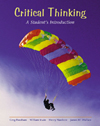
Finding, Evaluating and Using Sources |  |
Chapter OutlineOutline/Summary of Objectives in Chapter Twelve: Finding, Evaluating and Using Sources
Following are the main learning objectives from the chapter. A. Students should recognize the merit of good research habits in academics, professional life, and personal life. B. Students should recognize research as an avenue into important issues and as a means of developing one's own thinking. |
(See 355-364)
Finding Sources (pgs. 355-364) |
A. Students should develop basic skills and strategies for finding good sources of information. To this end, you should learn . . . 1. methods for refining your search. Once you have developed a focused question of investigation, you should become familiar with various library sources. a. directional materials such as: 1. bibliographies; 2. periodical indexes and abstracting services; 3. Internet search engines, guides, and directories. b. informational sources such as: 1. encyclopedias; 2. almanacs, yearbooks, fact books, directories, handbooks, manuals, and atlases; 3. biographical sources; 4. dictionaries; 5. government documents; 6. human sources. B. Students should develop basic skills and strategies for evaluating information sources. To this end, you should. . . 1. learn to effectively asses the content of information sources. In this aim, you must learn to . . . a. distinguish facts from nonfacts; 1. recognize whether a matter of fact is verifiable or not. b. separate objective and verified facts from unverified facts and all facts from everything else; 2. learn to asses the reliability of the author and the publisher of information sources. To this end, you should routinely ask the following questions: a. What is the author's background? b. What are the author's biases and interests? c. What are the author's sources? d. Who is the publisher or sponsor? 3. learn methods for distinguishing scholarly from nonscholarly periodicals and other sources. 4. learn to tips for evaluating electronic sources of information such as is found on the Internet. C. Students should learn to evaluate information sources through an assessment of the intended audience of that source. To this end, you should routinely ask: 1. Who is the intended audience? 2. How has the audience responded? |
(See 386-395)
Taking Notes (pgs. 386-395) |
Students should learn techniques for taking careful and effective notes. In particular, you should learn to . . . A. take careful and accurate notes of bibliographical information of sources you intend to use; B. take careful and accurate content notes. To this end, you should become familiar with notetaking standards and methods for . . . 1.citing quotations; 2.developing summaries; 3.paraphrasing sources; 4. recording your own insights and reactions to sources. |
(See 397-405)
Using Sources (pgs. 397-405) |
While learning to use and integrate sources into your own writing you should become proficient in the following: A. Acknowledging sources and avoiding plagiarism. To this end, you should . . . 1. understand which sources require documentation. a. Direct quotations b. Statistical information c. Facts that are not widely known d. Controversial facts e. Descriptions and visual aides such as graphs, tables and charts f. Unique verbal illustrations g. Original ideas that are not your own 2. Understand which sources do not require documentation. a. Widely known and indisputable facts b. clich and Egrave's and widely recognized literary quotations B. Incorporating sources into your own writing so as to best facilitate your own purposes, intentions and style. To this end, you should become effective in the integration of the following into your writing: 1. Words and phrases 2. Quotes and paraphrases of longer passages 3. Block quotations |
|
|